AMD Phenom 9600 Black Edition Review
AMD Phenom 9600 Black Edition
AMD's latest quad-core Phenom CPU has an unlocked multiplier for easy overclocking but is it enough to raise Phenom above Intel's quad-core offerings?
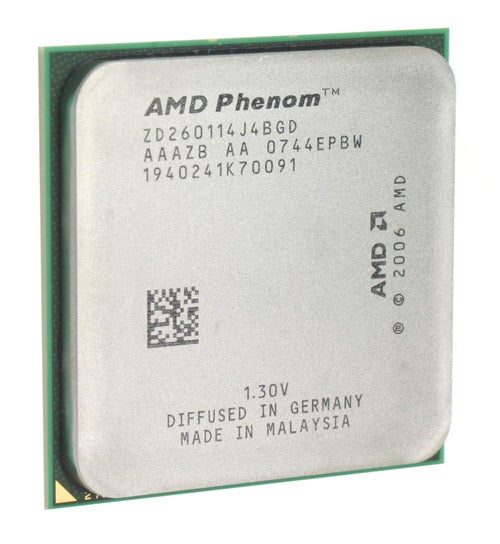
Verdict
Key Specifications
- Review Price: £155.00
You may or may not have noticed that we’ve yet to dedicate a review to AMD’s Phenom CPUs. This is for a number of reasons but mainly the lacklustre performance of the first batch of CPUs combined with the fact that our initial samples weren’t available at retail and were actually engineering samples with slightly different configurations, meant we never found a slot in our schedule that seemed appropriate.
A few months later, though, and we’ve received a CPU you can actually buy in the shops, in the form of the 9600 Black Edition, and we also have retail motherboards with mature BIOSes on which to test it. So, finally we can give Phenom a fair test and see if this much maligned CPU is a worthwhile purchase for those who require a bit more oomph than dual or single core CPUs can provide. 
Being our first look at these new CPUs, we’ll briefly cover the technology that powers them and compare it to the way Intel does things with its Core 2 Quad CPUs. After that we will move onto performance comparisons where we’ll see if all the technology actually makes for a CPU that’s faster in the real world.
We’ll start with the basics. All Phenoms will work with existing AM2 motherboards (assuming a BIOS update is available) so if you’ve stuck with the green team over the last year or two, buying a Phenom shouldn’t require you to upgrade the rest of your system. However, if you do use one of the newer 700-series boards that have AM2+ sockets, you will be able to take advantage of the more sophisticated power saving features whereby the voltage and clock speed of each CPU core can be changed depending on how much the core is being used. 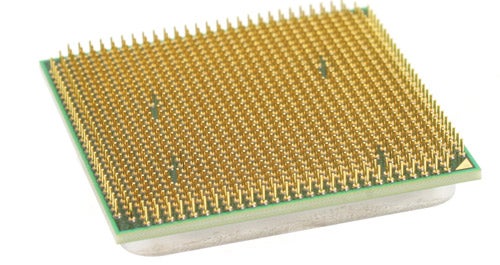
Also, AM2+ boards now use a faster 2GHz hyper transport (HT) link between the CPU and memory controller so theoretically the CPU will run faster on these newer boards. We have a suspicion that the impact of reducing the HT speed to 1GHZ, by running a Phenom in an AM2 board, would actually be fairly minimal but we haven’t checked whether this is the case, so feel free to report back your findings.
The execution component that sits at the heart of each core is largely the same as that used by the Athlon series of chips but with a number of tweaks here and there. For instance, SSE4 instructions are now supported and general SSE performance has also been improved, which should speed up games and other multimedia applications. There’s also improved hardware support for virtualization, a common technique for simultaneously running two operating systems on one PC. 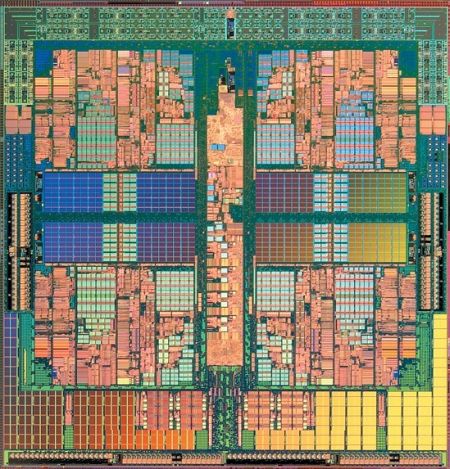
The on-die cache configuration has also changed with the addition of an extra shared layer known as L3. On-die cache memory is used to provide small very fast chunks of memory for the processor to access before it goes through the relatively lengthy process of retrieving data from main system memory. Finding the right balance of size and speed of cache can make all the difference to a CPU’s performance.
For Phenom, the first ‘layer’ of memory is just 128kB per core, but it’s very quick to access, the next layer (L2) is a more reasonable 512kB per core, but it takes more time to access. L3 is 2MB in size but this is shared between all four cores and takes even longer to access. This is in contrast to Intel’s quad-core CPUs that don’t use any L3 cache but instead have very large 8MB or 12MB L2 caches. The reason Phenom uses much smaller amounts of cache is because it includes an integrated memory controller that can communicate with memory much faster than Intel’s chips, so it simply doesn’t need as much.
For all its architectural improvements, though, the main feature of Phenom, which is supposed to make it better than Intel’s CPUs, is the fact it uses a native quad-core design rather than two dual-core CPUs bolted together on the same package. The advantage of this is that cores can communicate directly, without having to go via the slow front side bus (FSB), as is the case with Intel’s CPUs. So, where inter-core communication is required, Phenom should be faster. Conversely, the disadvantages are that each piece of silicon is considerably more complicated and the design is less scaleable – the complications of controlling communication between memory controllers means you couldn’t just slap two Phenom chips on the same package. 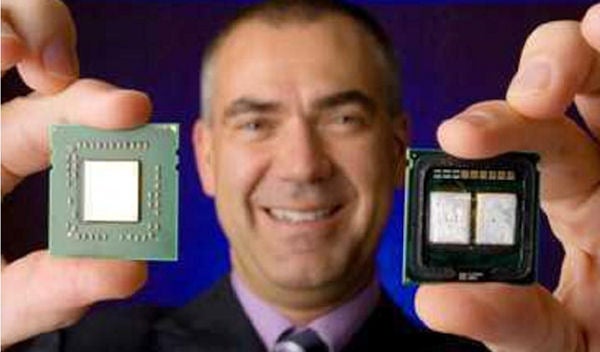
So on paper, Phenom has a lot going for it and, though it goes about things in very different ways, it should have proved to be a worthy adversary for the Intel Core 2 Quad chips. However, AMD has hit a few snags with its first raft of CPUs based on this architecture.
First was the TLB erratum that if unfixed could cause calculation errors in certain scenarios and if fixed resulted in a significant drop in performance. Then there was the fact AMD simply couldn’t seem to get the chips running fast enough. While Intel’s chips will happily run at upwards of 4GHz, AMD is still struggling to break 3GHz and most people are reporting that even 2.6GHz is a milestone. So, no matter what the architectural differences, Intel is able to hold a lead in performance due to sheer brute force speed.
To try and counter this, AMD has now released the AMD Phenom 9600 Black Edition. It features an unlocked CPU/FSB multiplier which means you can overclock your CPU not just by bumping up the FSB speeds but by increasing the multiplier. 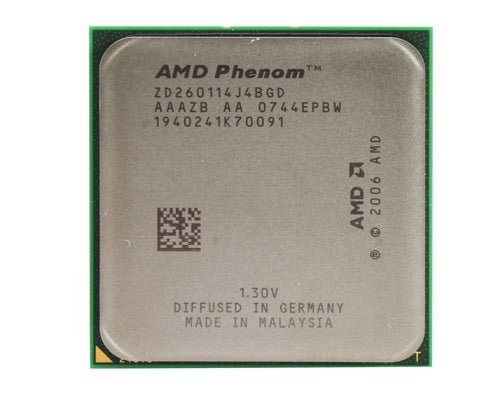
Now, multiplier unlocked CPUs are nothing new but they’ve normally demanded a hefty premium over locked CPUs so that the manufacturers can squeeze more money out of the enthusiasts that will pay for such privileges. However, because it’s trying so desperately to compete with Intel, AMD has offered up the 9600 Black Edition at a premium of only £10 over the standard 9600, which is really great to see. However, this really does highlight the problems AMD is having in getting its chips to consistently clock faster, as there’s no way they’d offer the 9600 Black Edition at such a low price if they could reliably squeeze more speed out of it.
Still, free performance increases are good and there’s always a chance you could get a good sample that overclocks to 3GHz or more – we’ve certainly heard of a few that have – so without further ado, let’s take a look at how our sample performs.
As the main competitors to the Black Edition are not the slower, cheaper Phenoms but rather Intel’s top-end CPUs, we’ve not included any scores for the phenom 9500. However, we have included one of AMDs previous best, the Athlon64 6000+. It’s not quite the fastest Athlon that AMD ever produced – that honour goes to the Athlon64 6400+ Black Edition – but it is the next step down and will provide a good reference point.
On the Intel side we’ve included its previous generation top-dog, the QX6700, which is the multiplier unlocked 65nm version of the Kentsfield quad-core range. We’ve also included the current champion, the 45nm Penryn based QX9770, which is also multiplier unlocked. We’ve left both running at standard speeds for a baseline comparison but the QX6700 can run at well over 3GHz and the QX9770 can push 4GHz so be aware that there’s plenty more head room in these CPUs.
For a price comparison we’ve also included the Q6600, which runs at 2.4GHz (but again can easily overclock to 3GHz) and can be had for £150. Lastly we’ve thrown in an Intel dual-core CPU in the form of the E6750, to give an overall picture of where the Phenom sits in terms of performance.
—-
”’Test Setup”’
”’Common Components:”’
*nVidia 8800 GTS 320MB
*400GB Seagate Barracuda 7200.9
*Microsoft Windows Vista Home Premium 32-bit
”’Intel Specific Components:”’
*2GB Corsair TWIN3X2048-1333C9 DDR3
*Asus P5E3
”’AMD Specific Components:”’
*2GB Corsair Dominator TWIN2X2048-8500C5DF DDR2
*MSI K9A2 Platinum
”’CPUs Tested”’
*AMD Phenom 9600 Black Edition (4×2.3GHz)
*AMD Athlon X2 6000+ (2×3.00GHz)
*Intel Core 2 Quad QX9770 (4×3.2GHz)
*Intel Core 2 Quad QX6700 (4×2.66GHz)
*Intel Core 2 Quad Q6600 (4×2.4GHz)
*Intel Core 2 Duo E6750 (2×2.66GHz)
—-
Testing started with our usual quartet of Photoshop batch processing, VirtualDub video encoding, WinRAR file compression, and LAME mp3 encoding. These tests are all single-threaded versions of the programs so they are only using one core at a time. Next we tested the multithreaded versions of WinRAR and LAME as well as the animation benchmark, Cinebench, to see how effectively the CPUs distribute the computing load across multiple cores. Finally, we did a spot of game testing using Counter-Strike: Source, Enemy Territory: Quake Wars, and Crysis.
As always we tried to create as even a playing field as possible so the only limiting factor for each setup is the CPU itself. Both test systems used Seagate Barracuda hard drives and nVidia 8800 GTS 320 graphics cards. However, we used DDR2 memory with the AMD CPUs, while the Intel chips were accompanied by DDR3 and of course the two motherboards for each platform were different. Each test was repeated until a consistent score was achieved so the results we’re showing are truly representative of the performance our test beds gave under our tests. 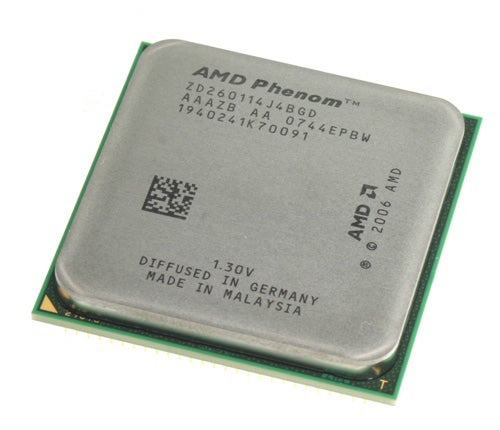
Following these initial tests we set about overclocking the Black Edition. We started by upping the FSB and were pleased to find we could get 220MHz running stable without too many problems. This gave us an overall clock speed of 2,530MHz, which wasn’t a bad start.
So, next we tried to increase the multiplier but we very quickly hit a brick wall – any increase was completely unstable, no matter how much we upped the voltages. So, we started clocking back the FSB to see if we could find an optimum balance between FSB and multipler. Unfortunately, we had to go all the way back to the standard FSB of 200MHz before we could up the multiplier and eventually we ended up with a best overclock of 13x200MHz, or 2,600MHz. This actually isn’t too bad considering we’ve heard of CPUs not playing ball at anything above standard clocks, but it’s still a long way off the competition from Intel.
The unfortunate thing for AMD, and annoying thing for the consumer, is our tests show there’s obvious potential for good performance scaling as clock speed increases. If only the chips would actually run faster. Hopefully in the near future AMD can turn out a tweaked version of Phenom that can push up to and beyond 3GHz. Otherwise it may have a real struggle on its hands.
”’Verdict”’
The Phenom line of CPUs has the potential for great performance. Unfortunately, problems with getting the chips to run at a high enough clock speed means they can’t compete with Intel at the top end. So, if you’re planning on a full system upgrade, we’d recommend going with an Intel chip.
If you’ve already got an AM2 motherboard and some decent DDR2 RAM and you just want a CPU upgrade then dropping £150 for a Phenom 9600 Black Edition will get you a nice boost in performance. However, we’d probably still recommend you wait for the release of the next line of Phenoms, which should clock higher.
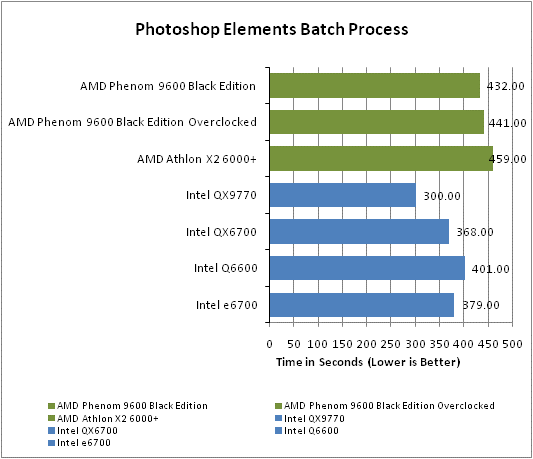
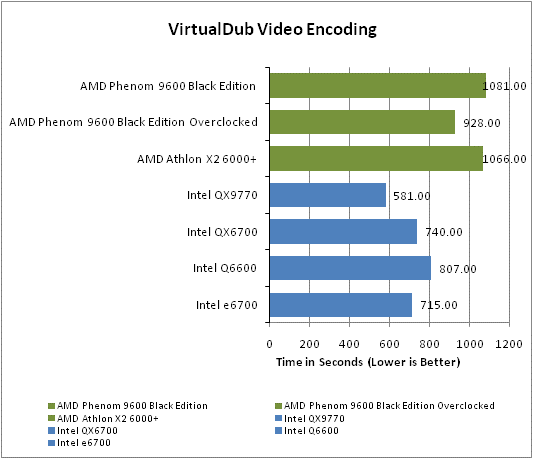
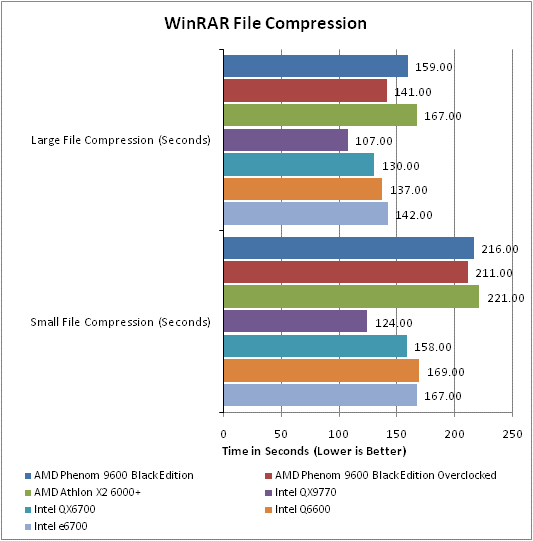
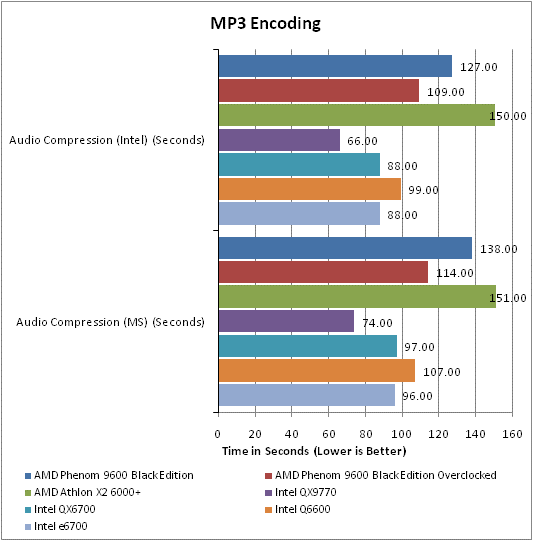
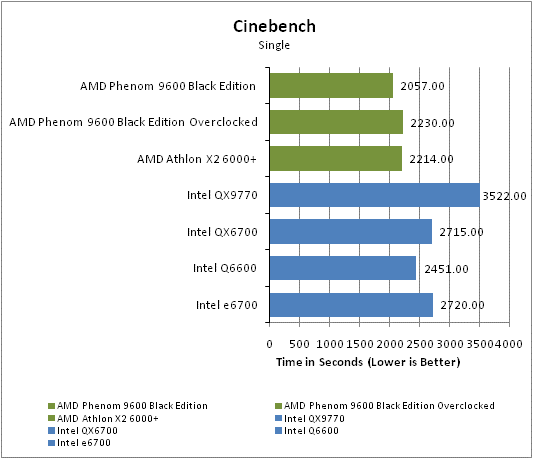
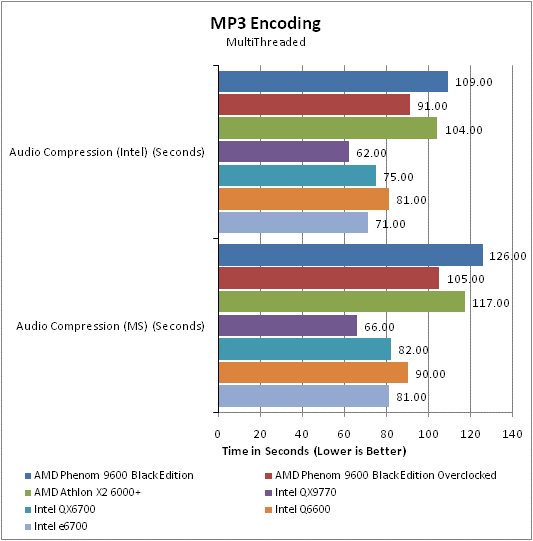
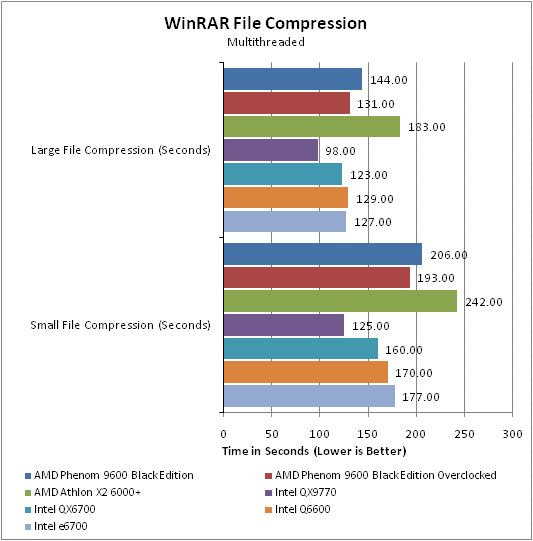
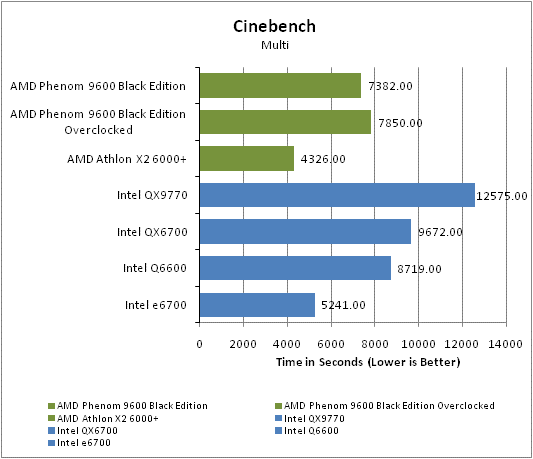
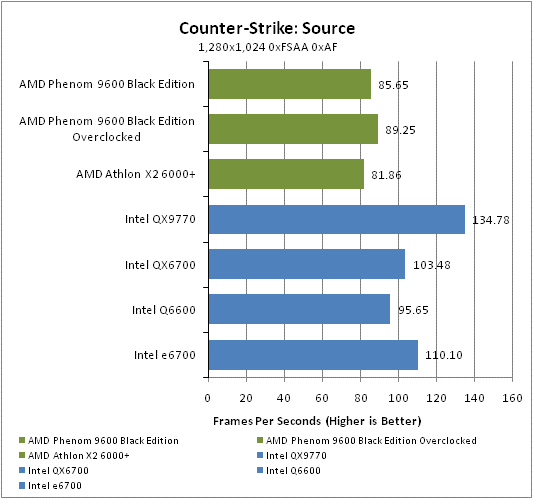
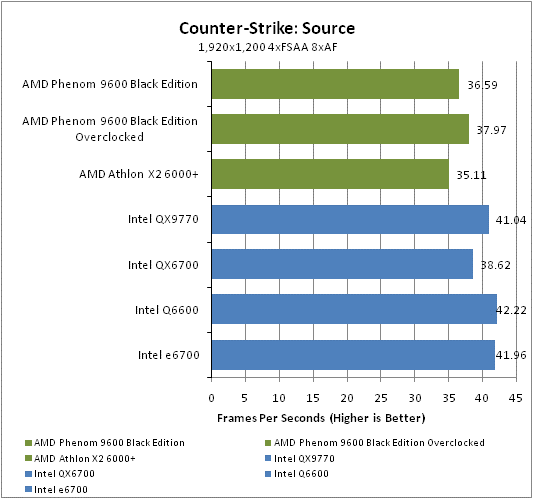
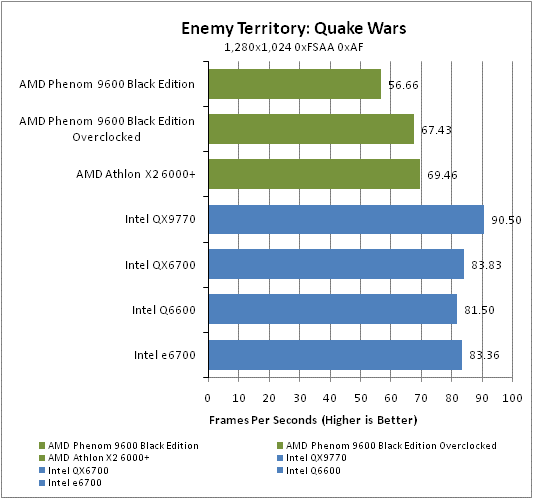
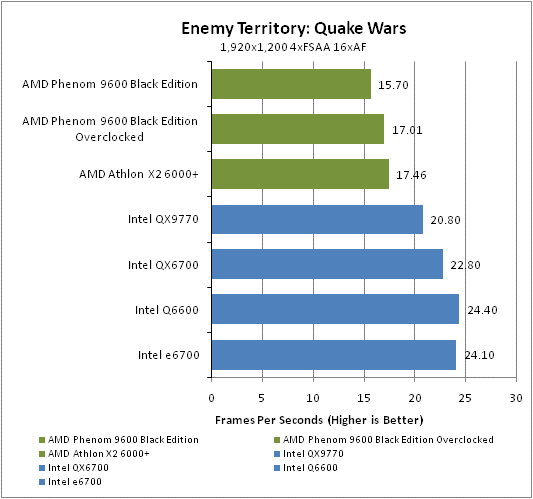
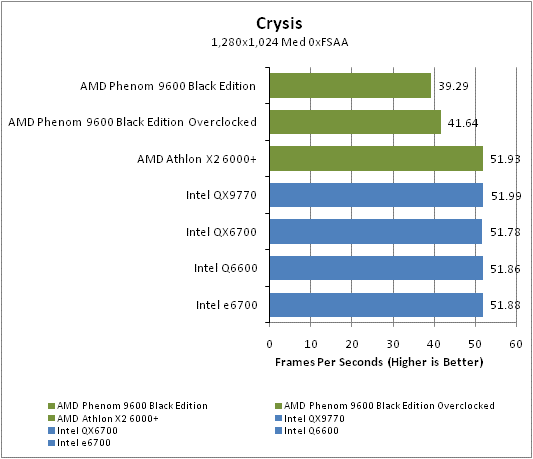
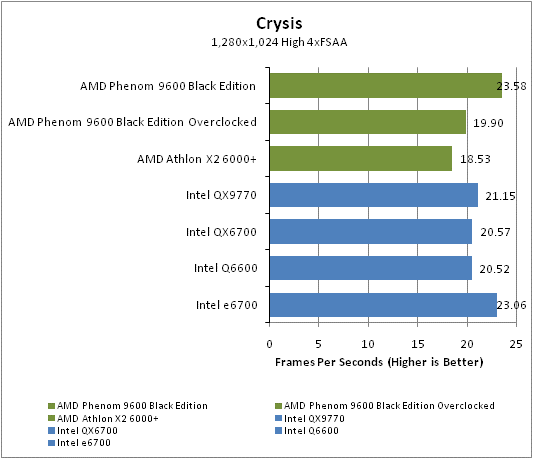
Trusted Score
Score in detail
-
Value 7
-
Features 8
-
Performance 6

